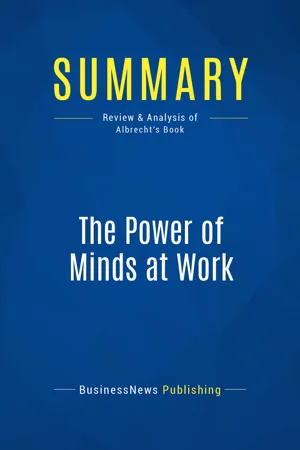
Summary: The Power of Minds at Work
Review and Analysis of Albrecht's Book
- English
- ePUB (mobile friendly)
- Available on iOS & Android
About this book
The must-read summary of Karl Albrecht's book: `The Power of Minds at Work: Organizational Intelligence in Action`.
This complete summary of the ideas from Karl Albrecht's book `The Power of Minds at Work` shows that when intelligent people are assembled in an organisation, they will tend towards collective stupidity. In his book, the author explains that in order to offset this law, organizational intelligence is needed. In practical terms, organisational intelligence is the antidote to collective stupidity and a deliberate effort to multiply and take advantage of the collective brainpower of everyone involved. This summary offers seven key traits of organisational intelligence that you can adapt and apply to ensure that your company is free from collective stupidity.
Added-value of this summary:
• Save time
• Understand key concepts
• Expand your knowledge
To learn more, read `The Power of Minds at Work` and find out how you can implement key traits into your business that will ensure the effectiveness of your intelligent employees.
Frequently asked questions
- Essential is ideal for learners and professionals who enjoy exploring a wide range of subjects. Access the Essential Library with 800,000+ trusted titles and best-sellers across business, personal growth, and the humanities. Includes unlimited reading time and Standard Read Aloud voice.
- Complete: Perfect for advanced learners and researchers needing full, unrestricted access. Unlock 1.4M+ books across hundreds of subjects, including academic and specialized titles. The Complete Plan also includes advanced features like Premium Read Aloud and Research Assistant.
Please note we cannot support devices running on iOS 13 and Android 7 or earlier. Learn more about using the app.
Information
Summary of The Power of Minds at Work (Karl Albrecht)
Trait #1: Strategic Vision
- A sound strategic concept – which details why the organization has been formed and what it is hoped it will achieve. This may be articulated in a simple mission statement which is succinct and applicable. For example, Disney’s strategic concept is: “To deliver a rich customer experience which is full of fun and fantasy delivered in a theatrical environment”. To retain its relevance, the strategic concept should be systematically evaluated each year and updated to reflect new trends, threats or opportunities.
- A workable value proposition – or a means by which the organization will convert the value it adds for customers into revenue. The value proposition is the organization’s promise to the marketplace.
- A good business model – which will provide the infrastructure by which the value proposition will be executed week-in and week-out.
- Management by objectives (early 1970s) – breaking everything down into key result areas, major goals and specific objectives.
- Productivity (late 1970s) – analyzing all the jobs, eliminating waste and optimizing each person’s contribution.
- Diversification (late 1970s and early 1980s) – branching out into different and completely unrelated lines of business to even out revenue flows in turbulent market conditions.
- Mergers and acquisitions (the 1970s and 1980s) – where companies believed they had to: “Get big or get eaten by someone else”.
- Behavioral sciences (early and mid 1970s) – where everyone tried to tie in corporate performance with human relations theories and the hierarchy of human needs.
- The “Excellence” movement (1980s) – in which everyone aspired to do things with a passionate commitment to excellence, despite the fact that meant different things to different people.
- The “One Minute Manager” approach (mid 1980s) – where everything in business could be boiled down to a business parable embodying timeless principles of leadership.
- Total quality management (early 1990s) – where business defects and costs could be reduced by paying close attention to the elements of the manufacturing process.
- Teams and empowerment (early 1990s) – where employees working together took more responsibility for their results.
- ISO 9000 (mid 1990s) – where the use of high quality auditing procedures would document and then hopefully enhance all business processes.
- Re-engineering (early 1990s) – in which organizations could be “fixed” by extending structured problem-solving methodologies into new parts of the business.
- Customer focus (mid 1990s) – based around the concept of service management rather than manufacturing thinking.
- Restructuring (late 1990s) – where core competencies, outsourcing, value chains and downsizing moved into the mainstream of business thinking.
Table of contents
- Title page
- Book Presentation
- Summary of The Power of Minds at Work (Karl Albrecht)
- About the Summary Publisher
- Copyright